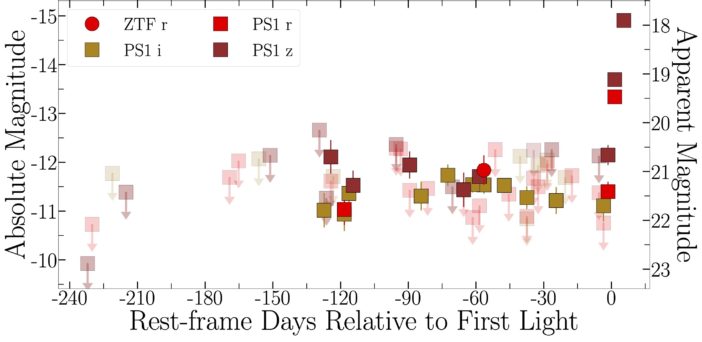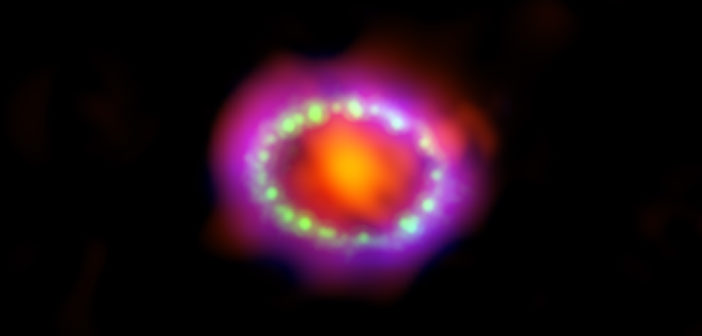Editor’s note: Astrobites is a graduate-student-run organization that digests astrophysical literature for undergraduate students. As part of the partnership between the AAS and astrobites, we occasionally repost astrobites content here at AAS Nova. We hope you enjoy this post from astrobites; the original can be viewed at astrobites.org.
Title: Final Moments I: Precursor Emission, Envelope Inflation, and Enhanced Mass loss Preceding the Luminous Type II Supernova 2020tlf
Authors: Wynn Jacobson-Galán et al.
First Author’s Institution: University of California, Berkeley
Status: Published in ApJ
Massive stars end their lives in energetic explosions known as core-collapse supernovae. Before exploding, however, some stars get the chance to say their final words! In the months leading up to the explosion, stars can expel some of their outer layers, which causes their brightness to increase dramatically. Today’s article describes a star that showed this “precursor emission” prior to the final supernova explosion.
SN 2020tlf: The Star That Spoke Before It Died
The supernova SN 2020tlf was discovered by the Asteroid Terrestrial-impact Last Alert System (ATLAS) survey on 16 September 2020 in the galaxy NGC 5731. The authors of today’s article noticed that this galaxy had also been observed by the Pan-STARRS telescope regularly since 18 January 2020 as part of the Young Supernova Experiment. The authors examined the data and voila! They found significant activity at the location of SN 2020tlf for more than a hundred days prior to the explosion. Figure 1 shows this precursor activity of SN 2020tlf.

Figure 1: Pre-explosion activity in SN 2020tlf lasting for 130 days (solid symbols), before the SN exploded. Symbols with arrows indicate upper limits on the brightness. [Adapted from Jacobson-Galán et al. 2022]
Precursor Emission = Signs of Mass Loss
The authors noted that the pre-explosion activity is detected only in the redder photometric r-, i-, and z-band observations, but it is absent from the bluer g- and cyan-band observations. This suggests that the precursor emission is red, suggesting that it comes from a “cold” surface (recall blackbody physics — bluer is hotter and redder is colder) with a temperature of 5000K and a radius of ~1,000 times the radius of the Sun. This is consistent with our understanding of a red supergiant star that is shedding its outer layers. From the precursor emission, the authors calculated that the red supergiant was surrounded by at least 0.3 solar mass of dense circumstellar material in its final days.
There are signs of this circumstellar material in the post-explosion observations as well. A spectrum taken just a few days after the explosion shows several narrow emission lines of hydrogen, helium, neon, and carbon, which are characteristic of a large amount of circumstellar material around the star. In addition, the early light curve shows signs that it is dominated by interaction of the supernova ejecta with this circumstellar material. From the light curve and spectra, the authors determined that the red supergiant was surrounded by 0.05–0.07 solar mass of circumstellar material, which is smaller than the mass derived from the precursor emission. The authors were not able to resolve this discrepancy satisfactorily, but they noted that it could be resolved if the precursor emission mechanism was super-Eddington in nature. Regardless of the exact quantity of circumstellar material, the red supergiant was losing mass at a rate of 0.01 solar mass per year in the months prior to explosion. This is significantly larger than mass-loss rates expected in normal stars (the Sun loses 10-14 solar mass per year).
What Caused the Mass Loss?
The leading theory for the enhanced mass loss is that it was triggered by an instability inside the star. One possibility is that the mass loss was driven by waves in the envelope of the star that were caused by the pulsations in the core. Such mass loss is possible for stars with masses less than 14 solar masses. However, in this model, the mass loss is expected to last for significantly longer than the 130 days observed for SN 2020tlf. A second model suggests that the mass loss was a result of some sudden energy deposition in the star’s envelope. If the deposited energy is equal to the binding energy of the star’s envelope, it can produce a detectable precursor emission that lasts for a few hundred days and has temperatures and luminosities roughly consistent with that of SN 2020tlf. This energy could be deposited by burning of oxygen and neon or silicon in the core of the star. However, additional studies are required to understand the exact reason for the precursor emission.
The authors noted that such precursor emission should be fairly common in Type II-P supernovae. However, as this emission is intrinsically faint, it is challenging to detect. Future, more sensitive surveys such as the Vera Rubin Observatory will be equipped to detect the final words of the stars.
Disclaimer: Today’s editor is in the same research group as first-author Jacobson-Galán but was not involved in this project. Jacobson-Galán is also an active Astrobites author but was not involved in the publication of today’s bite.
Original astrobite edited by Huei Sears.
About the author, Viraj Karambelkar:
I am a second-year graduate student at Caltech. My research focuses on infrared time-domain astronomy. I study dusty explosions and dust-enshrouded variable stars using optical and infrared telescopes. I mainly work with data from the Zwicky Transient Facility and the Palomar Gattini-IR telescopes. I love watching movies and plays, playing badminton and am trying hard to improve my chess and crossword skills.

